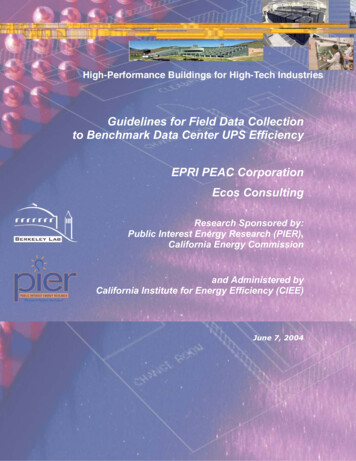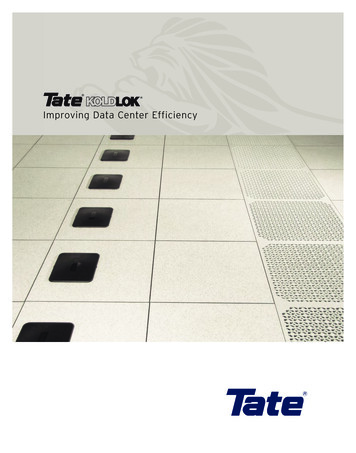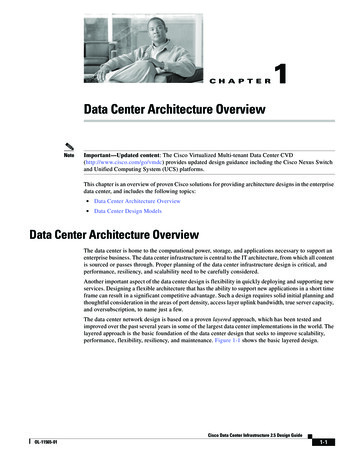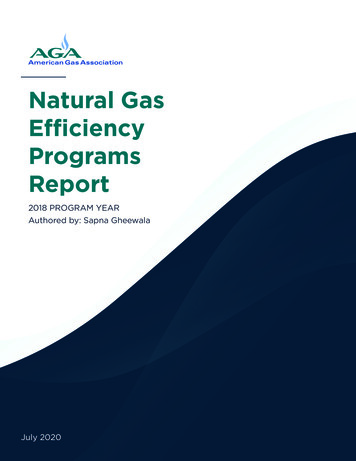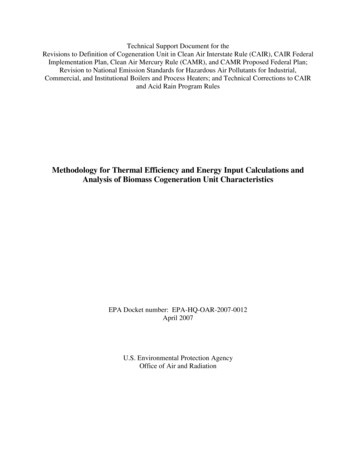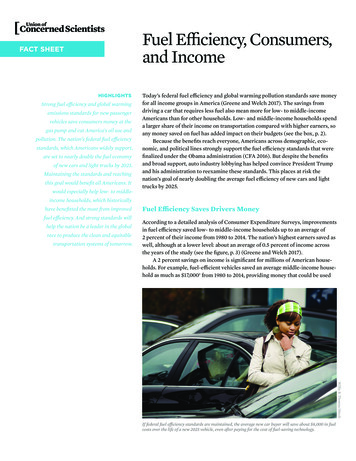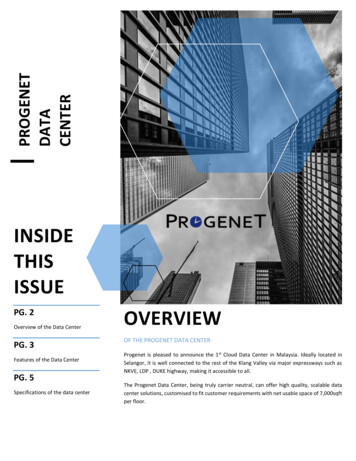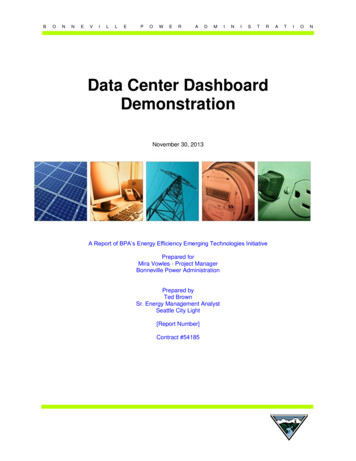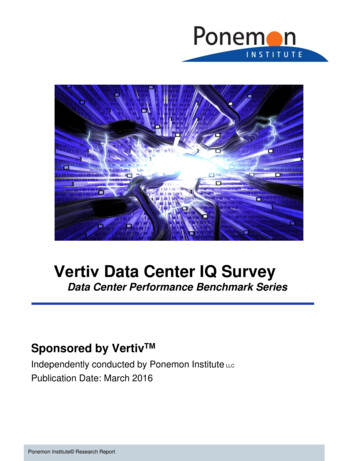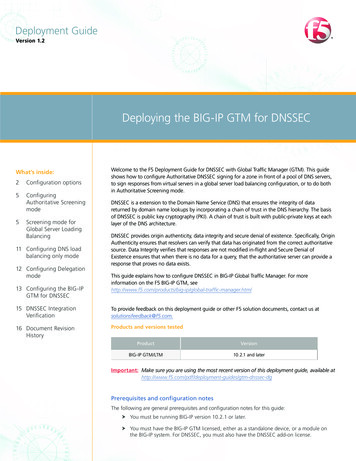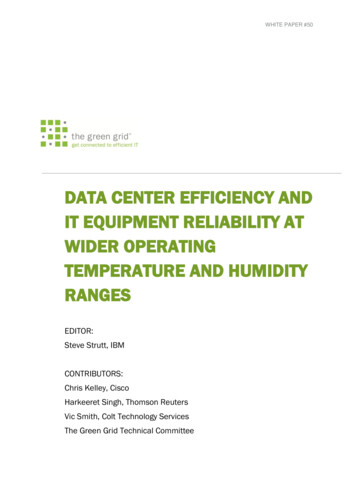
Transcription
WHITE PAPER #50DATA CENTER EFFICIENCY ANDIT EQUIPMENT RELIABILITY ATWIDER OPERATINGTEMPERATURE AND HUMIDITYRANGESEDITOR:Steve Strutt, IBMCONTRIBUTORS:Chris Kelley, CiscoHarkeeret Singh, Thomson ReutersVic Smith, Colt Technology ServicesThe Green Grid Technical Committee
PAGE 2Executive SummaryExtending the environmental operating parameters of a data center is one of the industry-acceptedprocedures for reducing overall energy consumption. Relaxing traditionally tight control over temperatureand humidity should result in less power required to cool the data center. However, until recently, theimpact of increased data center operating temperature on the information technology (IT) equipmentinstalled in the data center has not been well understood. Historically, it has been widely presumed to bedetrimental to the equipment’s reliability and service availability.Interest in the use of economization methods to cool data centers is helping to drive increased focus onextending the data center operating range to maximize the potential benefits of air-side and water-sideeconomizers in general. With economizers, the greater the number of hours and days a year that they canbe used, the less the mechanical chiller based cooling component of the infrastructure needs to operate.More importantly in some cases were economizers can be used, the benefits could be significant enoughto reduce the mechanical cooling capacity or even eliminate it altogether. Yet what effect does increasingthe operating envelope within the data center have on the reliability and energy consumption of the ITequipment itself? What if realizing savings in one area compromises reliability and increases energy usagein others?The Green Grid works to improve the resource efficiency of IT and data centers throughout the world. TheGreen Grid developed this white paper to look at how the environmental parameters of temperature andhumidity affect IT equipment, examining reliability and energy usage as the data center operating range isextended. Using recently published ASHRAE data, the paper seeks to address misconceptions related tothe application of higher operating temperatures. In addition, it explores the hypothesis that data centerefficiency can be further improved by employing a wider operational range without substantive impacts onreliability or service availability.The paper concludes that many data centers can realize overall operational cost savings by leveraginglooser environmental controls within the wider range of supported temperature and humidity limits asestablished by equipment manufacturers. Given current historical data available, data centers can achievethese reductions without substantively affecting IT reliability or service availability by adopting a suitableenvironmental control regime that mitigates the effects of short-duration operation at higher temperatures.Further, given recent industry improvements in IT equipment efficiency, operating at higher supportedtemperatures may have little or no overall impact on system reliability. Additionally, some of the emergingIT solutions are designed to operate at these higher temperatures with little or no increase in server fanenergy consumption. How organizations deploy wider operating ranges may be influenced by procurementlifecycles and equipment selection decisions.
PAGE 3Table of ContentsI.Introduction . 4II.History of IT Operating Ranges . 4III.Industry Change . 8IV.Concerns over Higher Operating Temperatures . 10IT reliability and temperature . 11Power consumption increase with temperature rise . 15V.Exploiting Air-Side Economizer Cooling . 18The effect of broadening operating regimes . 21Calculating the effect of operation in the Allowable range . 25The effect on data center energy consumption . 28Extreme temperature events . 29VI.Equipment Supporting Higher Operating Ranges . 30VII. Implications for the Design and Operation of Data Centers . 31Health and safety. 31Higher temperatures affect all items in the data center . 32Airflow optimization . 32Temperature events . 32Humidity considerations . 33Data floor design . 33Measurement and control . 33Published environmental ranges . 33VIII. Conclusion . 34IX.About The Green Grid . 35X.References . 35
PAGE 4I.IntroductionData centers have historically used precision cooling to tightly control the environment inside the datacenter within strict limits. However, rising energy costs and impending carbon taxation are causing manyorganisations to re-examine data center energy efficiency and the assumptions driving their existing datacenter practices. The Green Grid Association works to improve the resource efficiency of informationtechnology (IT) and data centers throughout the world. Measuring data center efficiency using The GreenGrid’s power usage efficiency (PUE ) metric reveals that the infrastructure overhead of precision cooling ina data center facility greatly affects overall efficiency. Therefore, solutions that can result in improvedefficiency deserve increased focus and analysis.Initial drivers for the implementation of precision cooling platforms within data centers have included theperceived tight thermal and humidity tolerances required by the IT network, server, and storage equipmentvendors to guarantee the reliability of installed equipment. Historically, many of these perceived tightthermal and humidity tolerances were based on data center practices dating back to the 1950s. Over time,the IT industry has worked to widen acceptable thermal and humidity ranges. However, most data centeroperators have been reluctant to extend operating parameters due to concerns over hardware reliabilityaffecting the availability of business services, higher temperatures reducing the leeway and response timeto manage cooling failures, and other historical or contextual perceptions.It is widely assumed that operating at temperatures higher than typical working conditions can have anegative impact on the reliability of electronics and electrical systems. However, the effect of operatingenvironment conditions on the reliability and lifespan of IT systems has been poorly understood byoperators and IT users. Moreover, until recently, any possible affects have rarely been quantified andanalyzed.Recent IT reliability studies show that, with an appropriate operating regime, a case can be made for theoperation of data centers using a wider temperature range and relaxed humidity controls. Using a looserenvironmental envelope opens the door to a potential reduction in some of the capital costs associatedwith a data center’s cooling subsystems. In particular, data centers that do not require a mechanical chillerbased cooling plant and rely on economizers can prove significantly less expensive both to construct andoperate.II.History of IT Operating RangesFor many years, a thermal range of between 20OC and 22OC has been generally considered the optimaloperational temperature for IT equipment in most data centers. Yet the underlying motivation for this ongoing close control of temperature and associated humidity is unclear. For instance, there is evidence that
PAGE 5the operating range was initially selected on the suggestion that this choice would help avoid punch cardsfrom becoming unusable. What is clear now, in hindsight, is that this type of tight thermal range wasadopted based on: The perceived needs and usage patterns of IT technologies when they were first introduced The environment within which vendors and operators were willing to warrant operation andguarantee reliability of those technologies The gravity of any existing assumptions about the use of tight control ranges in an environmentThis ad-hoc approach led to wide variability between vendors’ supported thermal and humidity rangesacross technologies, and it presented a significant challenge for users when operating multiple vendors’products within a single data center. Even when data center operators installed newer equipment thatcould support wider acceptable ranges, many of them did not modify the ambient operating conditions tobetter align with these widening tolerances.To provide direction for the IT and data center facilities industry, the American Society of Heating,Refrigerating and Air-Conditioning Engineers (ASHRAE) Technical Committee 9.9—Mission Critical Facilities,Technology Spaces, and Electronic Equipment—introduced its first guidance document in 2004. Theoperating ranges and guidance supplied within this seminal paper were agreed to by all IT equipmentvendors that were on the ASHRAE committee. In 2008, this paper was revised to reflect new agreed-uponranges, which are shown in Table 1.Table 1. ASHRAE 2004 and 2008 environmental Temperature20OC - 25OC18OC - 27OC15OC - 32OC10OC - 35OC40% - 55% RH5.5OC DP - 60% RH20% - 80% RH20% - 80% RHRangeMoistureRangeIn its guidance, ASHRAE defined two operational ranges: “Recommended” and “Allowable.” Operating inthe Recommended range can provide maximum device reliability and lifespan, while minimizing deviceenergy consumption, insofar as the ambient thermal and humidity conditions impact these factors. TheAllowable range permits operation of IT equipment at wider tolerances, while accepting some potentialreliability risks due to electro-static discharge (ESD), corrosion, or temperature-induced failures and whilebalancing the potential for increased IT power consumption as a result.
PAGE 6Many vendors support temperature and humidity ranges that are wider than the ASHRAE 2008 Allowablerange. It is important to note that the ASHRAE 2008 guidance represents only the agreed-upon intersectionbetween vendors, which enables multiple vendors’ equipment to effectively run in the same data centerunder a single operating regime. ASHRAE updated its 2008 guidance1 in 2011 to define two additionalclasses of operation, providing vendors and users with operating definitions that have higher Allowabletemperature boundaries for operation, up to 40OC and 45OC respectively. At the time this white paper waswritten, there existed only a small number of devices available that supports the new ASHRAE 2011 classdefinitions, which are shown in Table 2.Table 2. ASHRAE 2011 environmental classesASHRAE 2011 Equipment Environmental SpecificationsProduct OperationMaximumdew point(OC)Maximumelevation(m)Maximumrate ofchange(OC/hr)20 to 80% RH1730405/2010 to 3520 to 80% RH2130405/20A35 to 408 to 85% RH2430405/20A45 to 458 to 90% RH2430405/20B5 to 358 to 85% RH283040NAC5 to 408 to 85% RH283040NAClassesDry-bulbtemperature (OC)Humidity range non-condensing18 to 275.5OC DP to 60% RH and 15OC DPA115 to 32A2RecommendedA1 to A4AllowableASHRAE now defines four environmental classes that are appropriate for data centers: A1 through A4.Classes B and C remain the same as in the previous 2008 ASHRAE guidance and relate to office or homeIT equipment. A1 and A2 correspond to the original ASHRAE class 1 and class 2 definitions. A3 and A4 arenew and provide operating definitions with higher Allowable operating temperatures, up to 40OC and 45OCrespectively.Although the 2011 guidance defines the new A3 and A4 classes that support higher and lower Allowableoperating temperatures and humidity, vendor support alone for these ranges will not facilitate theiradoption or enable exploitation of the Allowable ranges in the existing A1 and A2 classes. Adoption isdependent on the equipment’s ability to maintain business service levels for overall reliability andavailability. Typical concerns cited by data center operators regarding the wider, Allowable operationalranges include uncertainty over vendor warranties and support and lack of knowledge about the reliabilityand availability effects of such operation. These are issues that must be addressed by the industry.
PAGE 7In its guidance, ASHRAE has sought to provide assurance about reliability when applying theRecommended and Allowable ranges. It should be noted, however, that few users were in a position toquantify the risks or impact associated with operating within the 2004 or 2008 ASHRAE Allowable or evenRecommended ranges. As a consequence, most data center operators have been wary of using the fullscope of the ranges. Some may tend to use the upper boundaries to provide a degree of leeway in theevent of cooling failures or to tolerate hot spots within the data center environment. A recent survey by TheGreen Grid on the implementation of the ASHRAE 2008 environmental guidelines in Japan2 showed thatover 90% of data centers have non-uniform air inlet temperatures and that the 2008 Allowabletemperature range is being used to address the issues of poor airflow management.The conservative approach to interpreting the ASHRAE guidelines on operating temperature and humidityhas presented a hurdle to the application of energy efficiency measures in the data center in some areas.This hurdle has not necessarily stifled innovation, as operators have been addressing overall data centerefficiency in multiple ways, but the available avenues for savings realization may have been narrowed as aresult. The Green Grid White Paper #41, Survey Results: Data Center Economizer Use,3 noted:The efficiency of data center cooling is being increased through better airflowmanagement to reduce leakage of chilled air and increase return temperatures.Contained aisle solutions have been introduced to eliminate air mixing, recirculation, andbypass of cold air. These approaches, even within the restraints of tight environmentalcontrol, have eliminated hot spots and brought more uniform inlet temperatures. As aconsequence, they have allowed higher ambient cold aisle supply temperatures withoutoverall change in IT availability and reliability.Many operators are implementing direct air cooled, indirect air cooled, and indirect watereconomizers to reduce the number of hours that an energy-hungry chiller plant needs tobe operated. The Green Grid survey of data center operators showed that use ofeconomizers will result in saving an average of 20% of the money, energy, and carbon forcooling when compared to data center designs without economizers.The increase in efficiency highlighted in White Paper #41 has largely occurred without any significantchanges in the way IT equipment is operated and the data center’s environmental characteristics areconfigured. Where uniform air distribution is implemented through the use of contained aisles or similarapproaches, loose control within the boundaries of the ASHRAE Recommended range can potentially allowfor increases in the number of hours of economizer operation available to the facility and drive furtherreductions in overall data center energy consumption and costs. Raising the supply temperature alsoprovides the opportunity for greater exploitation of economizers in hotter climates, where previously the
PAGE 8economic benefit was comparatively small due to the limited number of available operating hours. TheGreen Grid’s free cooling maps4 and web tools5 published in 2009 illustrate that when operation at up to27OC in the Recommended range is allowed, air-side economization can be exploited more than 50% ofthe time in most worldwide geographies. In higher latitudes, this opportunity increases to at least 80% ofthe time.The Green Grid’s 2012 free cooling maps6 illustrate operation up to the limits of the ASHRAE A2 Allowablerange of 35OC and demonstrate the potential for a greater impact of the use of economizers on energyefficiency. The maps show that 75% of North American locations could operate economizers for up to8,500 hours per year. In Europe, adoption of the A2 Allowable range would result in up to 99% oflocations being able to use air-side economization all year.Greater use of economizers also can drive down the potential capital cost of data centers by reducing thesize of the chiller plant needed to support the building or by possibly eliminating the chiller plant entirely inlocations where peak outside temperatures will not exceed economizers’ supported environmental ranges.Irrespective of the known benefits of raising supply temperatures, anecdotal evidence suggests that theaverage supply temperature of data centers has hardly changed in recent years. This conclusion issupported by the survey of Japanese implementation of ASHRAE 2008 environmental guidelines.2 Theprincipal reasons given for maintaining average supply temperatures around 20OC to 22OC are concernsabout the effect of temperature and humidity on IT hardware reliability and about the correspondingimpact on business service levels as the operating temperature is increased. Independently, operators alsocite as a barrier the lack of clarity provided by vendors on product support and warranty factors whenoperating outside the Recommended range. The lack of reliable information on these topics has deterredmany organizations from pursuing higher operating temperatures as a route to reduced energy costs.III.Industry ChangeThe rise of cloud computing as a new IT service delivery model has been the catalyst for innovation acrossthe whole spectrum of IT activities. This new model represents a conjunction of many existing and newtechnologies, strategies, and processes. For instance, cloud computing has brought together virtualization,automation, and provisioning technologies, as well as driven the standardization of applications, deliveryprocesses, and support approaches. Combined, these technologies, services, and capabilities havetriggered radical change in the way IT services are being delivered, and they have changed underlying coststructures and cost-benefit approaches in IT service delivery.Early cloud innovators identified data center facilities as a major, if not prevailing, element of their servicedelivery costs. After all, when looking at cloud services and increasingly at big data and analyticsoperations, any opportunity to reduce overhead and facility costs can reduce net unit operating costs and
PAGE 9potentially enable the data center to operate more economically. These savings can be used to increasethe scale of the IT environment.Inspired by their need for greater cost efficiencies related to supplying power and cooling for IT equipment,organizations operating at a cloud scale drove critical, innovative thought leadership. They were able toquickly demonstrate that air-side economizers and higher temperature data center operations did not havemeaningful impacts on reliability and availability when measured against their service delivery targets. Thislatter point is important—the service levels offered in most cases were not necessarily the same as mightbe expected from an enterprise with a traditional IT model that assumes high infrastructure reliability andmultiple component redundancy to deliver IT services.The IT hardware used by some of these cloud services operators was typically custom built to their ownspecifications. Further, these cloud services operators were able to effectively decouple the services theyoffered from potential failures of individual compute or storage nodes and whole racks of IT equipment.They were even able to decouple the services from a complete failure of one (of several) data centerfacility. This type of abstraction from facility and IT hardware failure requires a very robust level of IT servicematurity—a level that only recently is becoming a realistic target for most mainstream enterprise ITorganizations. Nonetheless, the success of the cloud service organizations and their IT and businessmodels has shown that there is room for innovation in more traditional data center operations and thatprevious assumptions about data center operation can be challenged.Most organizations do not have the luxury of being able to specify and order custom-designed, custom-builtIT equipment. Thus, any challenge to existing assumptions about data center operations has to occurwithin the confines of the available industry standard server (ISS) platforms across the industry. To helpdetermine the viability of operating ISS platforms in a completely air-side-economized data center with awider operating range than specified under ASHRAE 2008, Intel ran a proof of concept in a dry, temperateclimate over a 10-month period, using 900 commercially available blade servers. Servers in the air-sideeconomized environment were subjected to considerable variation in temperature and humidity as well asrelatively poor air quality. Even then, Intel observed no significant increase in server failures during theirtest period. “We observed no consistent increase in server failure rates as a result of the greater variationin temperature and humidity, and the decrease in air quality,” noted Intel in its August 2008 report.7 Whilethis was not a strictly scientific study, it did confirm that industry standard servers could be used in thisfashion and that further study and use was appropriate.The Green Grid has observed a slow but steady increase in the adoption of wider operating envelopes. Forexample, Deutsche Bank recently announced its construction of a production data center in New York Citythat is capable of handling nearly 100% of the cooling load by using year-round air-side economization. Thebank is able to cool its data center with no mechanical cooling necessary for at least 99% of the time
PAGE 10through a combination of facilities innovations and the willingness to operate IT equipment at an expandedenvironmental range.8IV.Concerns over Higher Operating TemperaturesEven given the data from the Intel study and the general trend toward leveraging wider operatingenvelopes, concerns about reliability and possible service-level impacts are not without merit. Therelationship between increased temperatures and failure rates of electronics is well known and widelyused to reduce the time required to perform reliability testing. What is not as well understood is the effectof temperature on the long-term reliability of IT equipment, apart from anecdotal evidence that servers inhot spots fail more frequently. There also remains disagreement on the importance and definition of “longterm” for most organizations. Effects such as ESD, particulate contamination, and corrosion at higherhumidity levels also need to be considered.Even if the theoretical potential for meaningful increases in failure rates was discounted, there remainmore practical and immediate considerations to address when looking at wider operating ranges,especially at the higher end of the thermal range. There is a relationship between temperatures above acertain point and an increase in server power utilization. This relationship is largely due to the increasedserver fan power required to cool components and, to a lesser extent, to an increase in silicon electricalleakage current when operating at higher ambient temperatures.9Additional observations show that some traditional, mechanical chiller cooled data centers have a “sweetspot” where operators can minimize overall energy consumption. This point exists at the intersectionbetween the mechanical cooling energy consumption (which decreases as the operating temperatureincreases) and the IT equipment energy consumption (which increases as ambient air temperature risespast a point). Whereas chiller efficiency improves with increasing inlet supply temperature and reducesenergy consumption, the power consumption of the IT equipment increases with inlet temperature past apoint, which can be expected to vary between device types.10, 11Data center operators frequently cite the perceived potential impact of higher temperature operation onsupport and maintenance costs as a significant deterrent to adopting wider operating ranges. Most ITequipment vendors warrant recent equipment for operation in both the 2008 and 2011 Recommendedand Allowable ranges of the ASHRAE classes. However, there is often some ambiguity as to any operatingrestrictions, and vendors do not necessarily clearly articulate the duration of supported operation at thelimits of the ranges. In recognition of the lack of clarity on warranties, the European Union, in its 2012update of the Code of Conduct for Data Centre Energy Efficiency,12 added a requirement for vendors toclearly publish information that specifies any such limitations in the operation of IT equipment.
PAGE 11IT RELIABILITY AND TEMPERATUREThe lack of historical authoritative data on any change in reliability that may occur when operating ITequipment at wider thermal and humidity bands has been a stumbling block to change. This historicalmurkiness has stopped some users and operators from building models and business cases todemonstrate that an economized data center using higher temperatures is viable and will not meaningfullyand negatively affect the level of business service offered.The Intel study in 2008 was the first study made public that used industry standard servers to demonstratethat reliability is not significantly or materially affected by temperature and humidity. At the time the Intelstudy was released, this conclusion was met with surprise, although perhaps it should not have beenunexpected. For many years, IT systems design specifications have required that high-power componentsbe adequately cooled and kept within vendors’ specifications across the equipment’s supported operatingrange. ASHRAE published data in its 2008 guidance paper, Environmental Guidelines for DatacomEquipment—Expanding the Recommended Environmental Envelope, that documented the change ofinternal component temperature for a typical x86 server with variable speed fans as the inlet airTemp OCWatts (Fan)temperature changed. (See Figure 1.)Source: ASHRAE 2008 ThermalGuidelines for Data ProcessingEnvironmentsInlet Temp OCFigure 1. Internal component temperature and fan power against inlet temperatureThe 2008 ASHRAE paper shows that the external temperature of the processor packaging (TCASE) remainsfairly constant and within its design specification, largely due to server fan speed increasing to mitigate theeffect of the external temperature increase. As a consequence, the reliability of this component is notdirectly affected by inlet temperature. What can be established is that server design and airflowmanagement are crucial influences on the reliability of server components, due to the change in operatingtemperature of these components, but the servers are designed to mitigate changes in inlet temperaturesas long as those changes stay within the equipment’s designated operating range.
PAGE 12What can also be seen from this data is that server fan power consumption rises rapidly to provide thenecessary volume of air flowing through the processor heat sinks to maintain the component temperaturewithin the allowed tolerance. Also note that the increase in fan power consumption only becomesmeaningful past roughly 25oC, toward the limit of the Recommended range. Specifically, the increase indata center operating temperature had no impact on server power consumption until the inlet temperaturereached this range. (Newer equipment and equipment designed to class A3 exhibits slightly differentcharacteristics and will be discussed later.)The industry’s understandable focus on life cycle energy consumption for devices has driven a number of
technology (IT) and data centers throughout the world. Measuring data center efficiency using The Green Grid's power usage efficiency (PUE ) metric reveals that the infrastructure overhead of precision cooling in a data center facility greatly affects overall efficiency. Therefore, solutions that can result in improved
